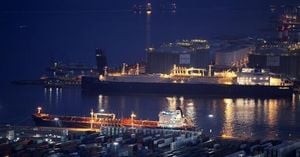Subsea cables, often overlooked yet pivotal, form the backbone of global communication, dictifying how our digital world connects. Recently, several outages caused substantial disruption across the Baltic Sea region, igniting concerns about the vulnerabilities of these underwater networks.
To put it simply, subsea cables are like the arteries of the internet: they carry the flow of information between countries, continents, and even small islands. Stretching thousands of miles under the ocean, these cables enable nearly all international internet and phone communication. Without them, the digital world would choke, significantly hampering functions ranging from simple email exchanges to high-level business transactions.
Now, what sparked the latest concern? Reports indicate extensive outages of these cables within the Baltic Sea, disrupting internet connectivity for many countries dependent on this digital lifeline. Countries affected include not just the immediate neighbors like Sweden, Finland, and Denmark, but even as far as Estonia.
The recent outages were triggered by damage to the subsea cable infrastructure, which experts say could have been due to several reasons, including severe weather conditions and shipping activity. Ships' anchors, fishing gear, and even natural geological activities can inflict harm on these cables. Such incidents raise alarms about how resilient these cables are to both human activities and natural phenomena.
Data received during this outage showcased significant speed drops and interruptions to services across various platforms. Users reported frustrating ping times and connection losses on popular streaming services and social media platforms. The ripple effect was felt far beyond the local level, impacting businesses relying on quick and reliable internet for operations.
One might wonder how often these outages happen? According to recent statistics, infrastructure failures such as this one, though seemingly uncommon, are becoming increasingly frequent as the age and number of cables grow older. Many cables were laid decades ago, and with the relentless demand for bandwidth from video streaming, online gaming, and remote work, they face unprecedented stress.
Interestingly, harmonic currents and electromagnetic interference, though lesser-known to the average person, also contribute to disturbances. These phenomenon can degrade the performance of the cables, affecting the very signals they carry. Recent studies indicate this is an area requiring more research, with experts advocating for advanced cable monitoring systems to detect issues before they lead to significant outages.
But it’s not all doom and gloom. The marine tech sector is actively working on developing solutions to fortify these subsea cables against mishaps. Innovations such as automatic cable laying systems and more resilient materials are now being experimented with. These advancements hold promise, but only if they are implemented at scale.
Countries are also stepping up their game. New partnerships and joint initiatives are being established to safeguard these undersea lines. For example, collaborations between tech companies and governments aim to deploy more resources for cable maintenance and repair, ensuring swift responses to any damage.
With the heightened tensions globally, discussions have also begun focusing on securing and protecting underwater infrastructure. The importance of safeguarding this digital highway – touted as the “internet’s lifeline” – was never clearer. Experts argue for international agreements to prevent damage caused by negligence or reckless fishing practices, with proposals for creating safe zones around the cables being floated around.
Many nations have also recognized the economic stakes tied to reliable internet access. Sweden and Finland, for example, have made significant investments to improve their internet services and reliability. The idea is to build redundancy within the network to avoid dependence on single cables. Now, if one cable were to get damaged, others would support the load, maintaining uninterrupted connectivity.
Adding yet another layer of complexity, as nations increasingly rely on these undersea systems, geopolitical stakes rise. Surveillance concerns have led to discussions about the need for securing these cables from potential threats. With heightened military activity and increased shipping traffic, experts caution against neglecting these vulnerabilities.
Meanwhile, this digital infrastructure is not just about smooth streaming movies or uninterrupted video calls. It also plays a pivotal role for banks and financial institutions. The ripple effect of outages can trigger delays, causing losses and bankruptcies for companies reliant on international transactions. This financial aspect alone highlights the necessity for uninterrupted subsea communication networks.
People often take the internet's reliability for granted, not realizing the daily operations dependent on these cables. For businesses, delays and outages can pose significant risks, potentially leading to customer dissatisfaction and financial repercussions. Different sectors, from e-commerce giants to small businesses, depend on seamless internet usage, and planned outages or damages often lead to significant losses.
The Baltic sea incident served as a wake-up call to many. The necessity for maintaining this network is not just about internet reliability; it’s about safeguarding national economies and ensuring daily communications remain intact. Countries, businesses, and tech firms must work cooperatively and pro-actively to secure these cables, acting quickly to respond to any damage.
While subsea cable systems are becoming more commonplace, enhancing their design to withstand unpredictable conditions becomes increasingly important. Collaboration is key here, as nations are urged to come together, engage with local economies and create effective awareness campaigns highlighting the importance of protecting this underwater infrastructure.
Lastly, acknowledging the even larger systemic risks and challenges is necessary. Climate change continues to threaten the integrity of this digital highway, impacting the sustainability of marine ecosystems and exacerbated by rising global temperatures. The call for ensuring the protection of undersea cables against environmental and anthropogenic pressures is more urgent than ever.
Every outage tells stories of connection, struggles, and resilience. And as the world becomes increasingly interconnected through the internet, securing subsea cables must be at the forefront of our global discussions. After all, maintaining the integrity and reliability of our communication networks is not just about convenience; it’s about safeguarding our future.



